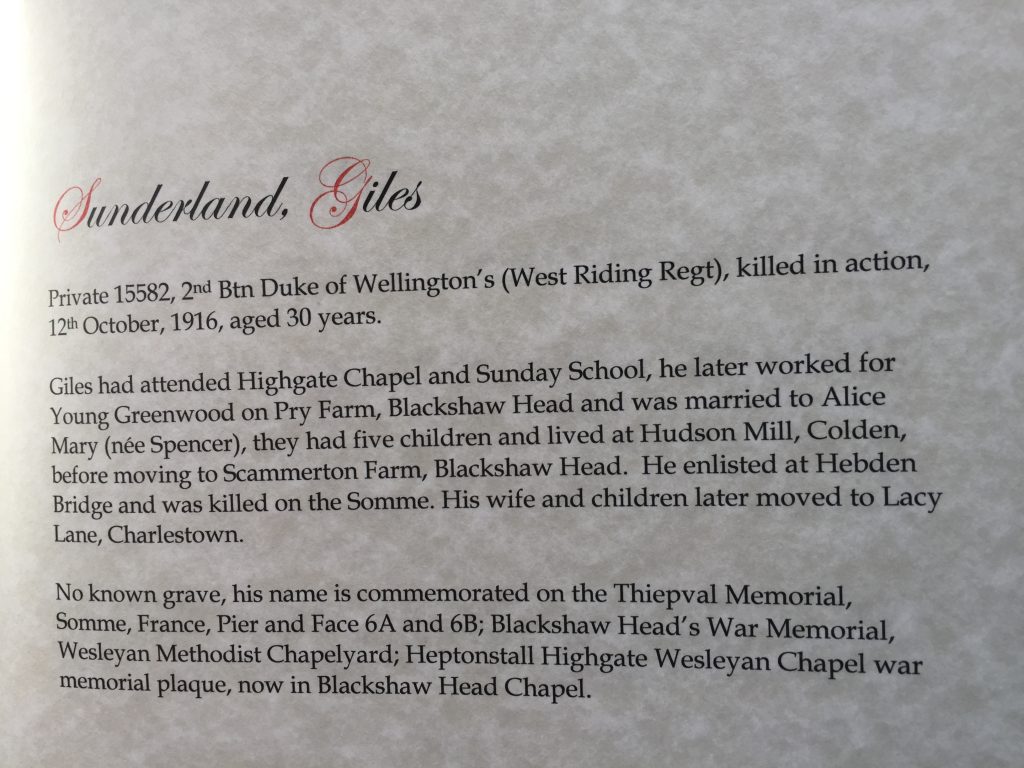
In the memorial book
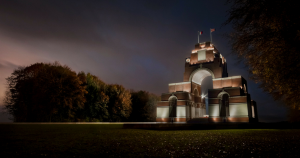
Thiepval memorial, France
I’d discovered that Blackshaw Head chapel where Giles Sutherland is named on the WWl memorial is open occasionally but when I used the ‘contact us’ page on the website I hadn’t got a response. Anyway, after a bit of to-ing and fro-ing I received welcoming invitation from someone called Roger who told me that the chapel would be open this morning for an arts and crafts class and I should ask for Dot. The morning dawned bright and sunny so I took the bus up to Blackshaw and arrived at 11.30, in time for the start of the class. My heart sank, however, when both doors into the building were well and truly locked, so I walked around to the back for the chapel, where an extension has been added and sure enough that door was open. I headed for a room from where I could hear voices and found half a dozen ladies just getting organized for a craft workshop. “I’m looking for Dot.” “I’m Dot, and you must be Heather. Roger said you might come. Bye ladies. You’ll have to manage the class without me. I’m going to show Heather around the chapel,” and with that settled we were off. Dot was the most wonderful raconteur, and before I knew it an hour and a half had passed by!
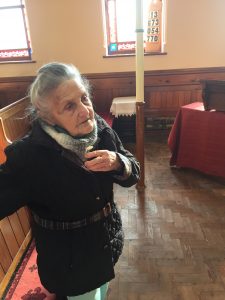
The incomparable Dot
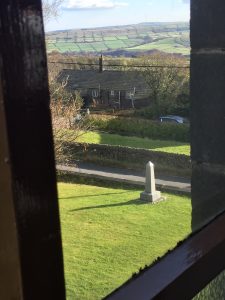
WWl memorial from the chapel balcony window – with the Erringden Grange’s model farm walls in distance

Ladybird on the quilt
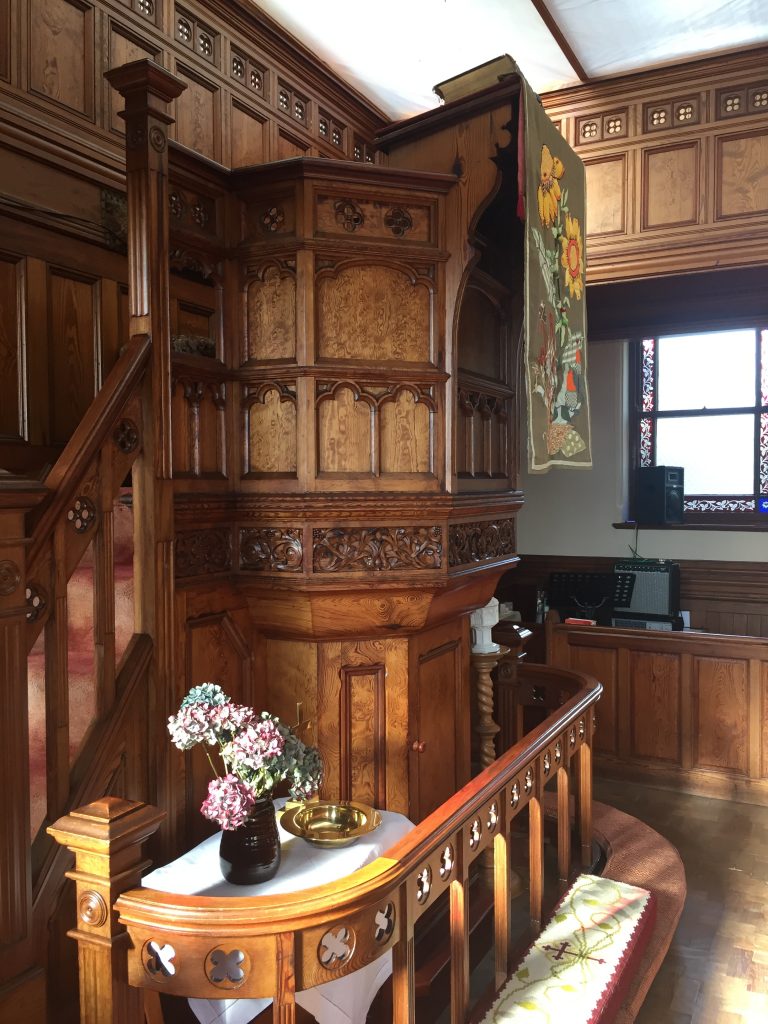
Magnificent pine pulpit

This bible in the pulpit dates from 1901
It turns out that Dot is an honorary life member of the Hebden Bridge Historical society – of which I am a paid up member! It’s the only branch of the Literary and scientific society that still exists. An early founding member and secretary was none other than one of my Gibson ancestors. “Ah, Eddie Binney Gibson,” said Dot without a moment’s hesitation. I told her that I’d ‘found’ the birdbath in his memory in New Street gardens. She knew all about it – of course she did!
The chapel’s classroom reminded me so much of Affetside Sunday school that I attended both on Sundays but also doubled as the two room classroom where I went to school until I was eleven. Even the screens with the class upper panels were the same – and the row of hooks on the wall for hanging your coats. The chapel itself was smaller than Affetside but it had a balcony but the layout and just the feel of the place was very familiar. The woodwork is highly polished and quite ornate. I thought it was walnut but Dot assured me it is pine. Like Affetside the pulpit is a very ornate affair. It had an applique banner that the arts and crafts ladies had made and three ladybirds were featured. An improvised roof had been added to the lower floor to help conserve heat, but Dot explained that for special services, especially at Christmas the plastic sheet is taken off and it’s standing room only. In the vestry is a book. There’s no record of the name of the author but it’s a recent book, with half a page about each member of the village who was involved in WWl. Here I found a couple of paragraphs about Giles, all of which, I was comforted to know, supported my own research and just added a couple of facts. From the gallery I could see the War memorial in the cemetery below, and also look across the valley to Stoodley Pike. I mentioned that I hiked up to the Pike on Sunday. “Did you go through Horsehold?” dot asked. “Yes, the first farm at the top of the hill from Hebden Bridge.” “My husband grew up there,” said Dot proudly. We chatted about the big farm further on, the one that had been part of the model farm, Erringden Grange. I’d taken photos of this farm complex before. It turns out that her husband’s family had lived there, but now it’s occupied just by one lady.
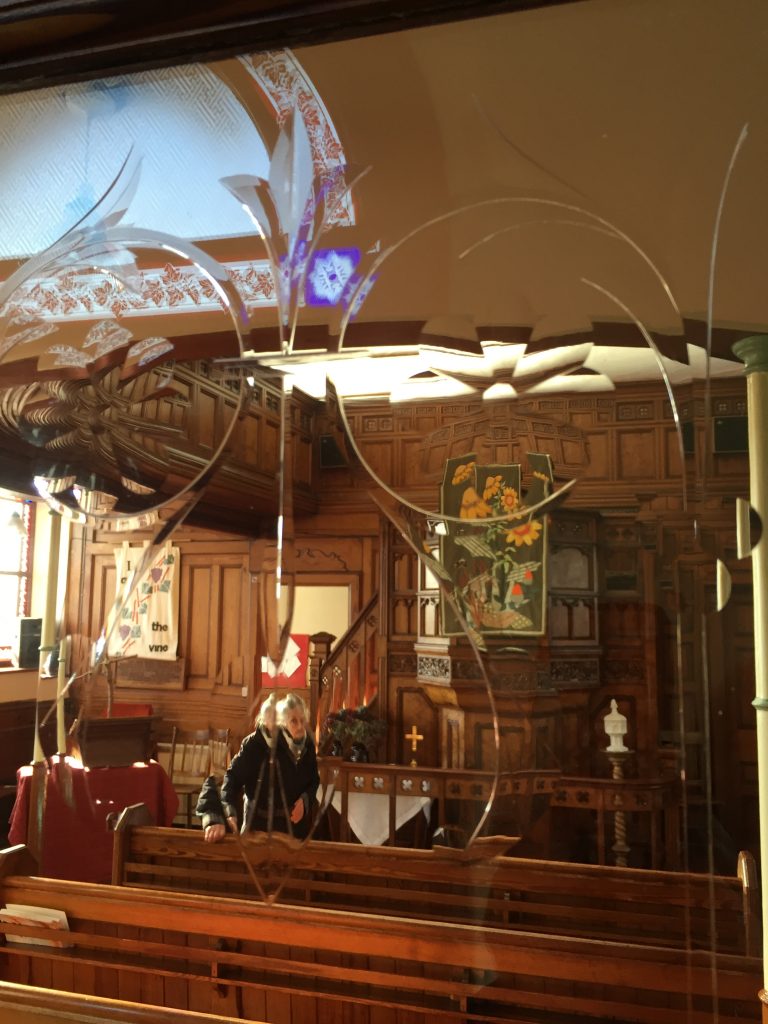
Having fun taking photos through the cut glass door panels
At one time the chapel’s roof leaked badly and services were conducted in a classroom -“like the Black Hole of Calcutta” Dot said. The church was going to close its doors forever, just like all the hilltop chapels around Calderdale – Highgate and Slack (built by my Wrigley ancestors) being two that closed. So Dot and a lay preacher, Roger, had decided to do something to keep it open and they spear-headed the fundraising that renovated the building. I asked if they’d been given special funding like the Octagonal chapel in Heptonstall. I mentioned that I’d once had a lovely chat with the lady who does the flowers in the Heptonstall chapel. “Oh, Jesse? That’s my sister in law.” “No. We’re not a listed building.” I was surprised. “Well. I knew the man who was going 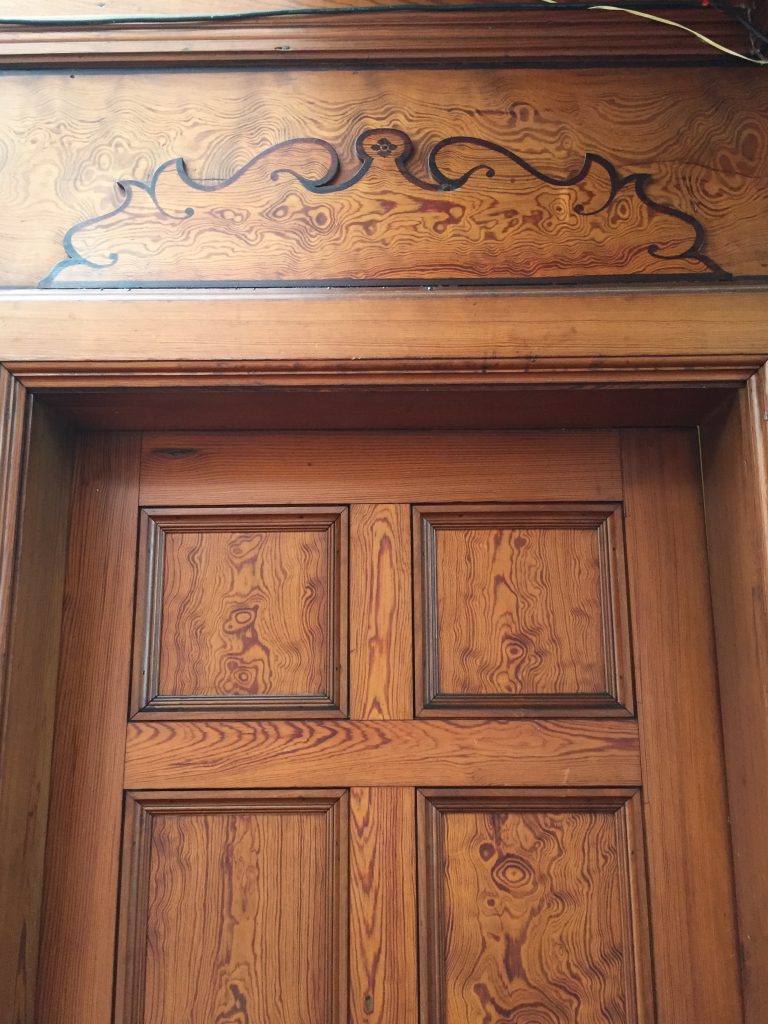 around doing the ‘listing’ and the doors to this chapel were locked that day. It looks austere and dull from the outside so he didn’t list it. Thank goodness! If we’d have been Grade 1 or Grade 2 listed we wouldn’t have been able to do all the things we have done – like build the extension on the back.” As we chatted a man came in to collect some posters and as Dot explained why I was there he invited me to a special celebration of the people of Blackshaw who returned from fighting in WWl but then had to deal with ‘a living hell’ for the rest of their lives. He introduced himself as Tim, and he also told me about A Beacon of Light that’s going to be lit on Great Rock above Eastwood featuring a handbell choir on the evening of Armistice Day. “I’ll see if I can arrange transport, if you need it” he offered. When he’d gone Dot explained that ‘Tim’ is none other than Mr Timothy James Pitt, Vice Lord Lieutenant, one time High Sheriff of West Yorkshire whose interests include ‘country pursuits, classic cars, gardening, golf, breeding Alpacas.’ http://www.westyorkshirelieutenancy.org.uk/vice-lord-lieutenant/
around doing the ‘listing’ and the doors to this chapel were locked that day. It looks austere and dull from the outside so he didn’t list it. Thank goodness! If we’d have been Grade 1 or Grade 2 listed we wouldn’t have been able to do all the things we have done – like build the extension on the back.” As we chatted a man came in to collect some posters and as Dot explained why I was there he invited me to a special celebration of the people of Blackshaw who returned from fighting in WWl but then had to deal with ‘a living hell’ for the rest of their lives. He introduced himself as Tim, and he also told me about A Beacon of Light that’s going to be lit on Great Rock above Eastwood featuring a handbell choir on the evening of Armistice Day. “I’ll see if I can arrange transport, if you need it” he offered. When he’d gone Dot explained that ‘Tim’ is none other than Mr Timothy James Pitt, Vice Lord Lieutenant, one time High Sheriff of West Yorkshire whose interests include ‘country pursuits, classic cars, gardening, golf, breeding Alpacas.’ http://www.westyorkshirelieutenancy.org.uk/vice-lord-lieutenant/

View from the balcony
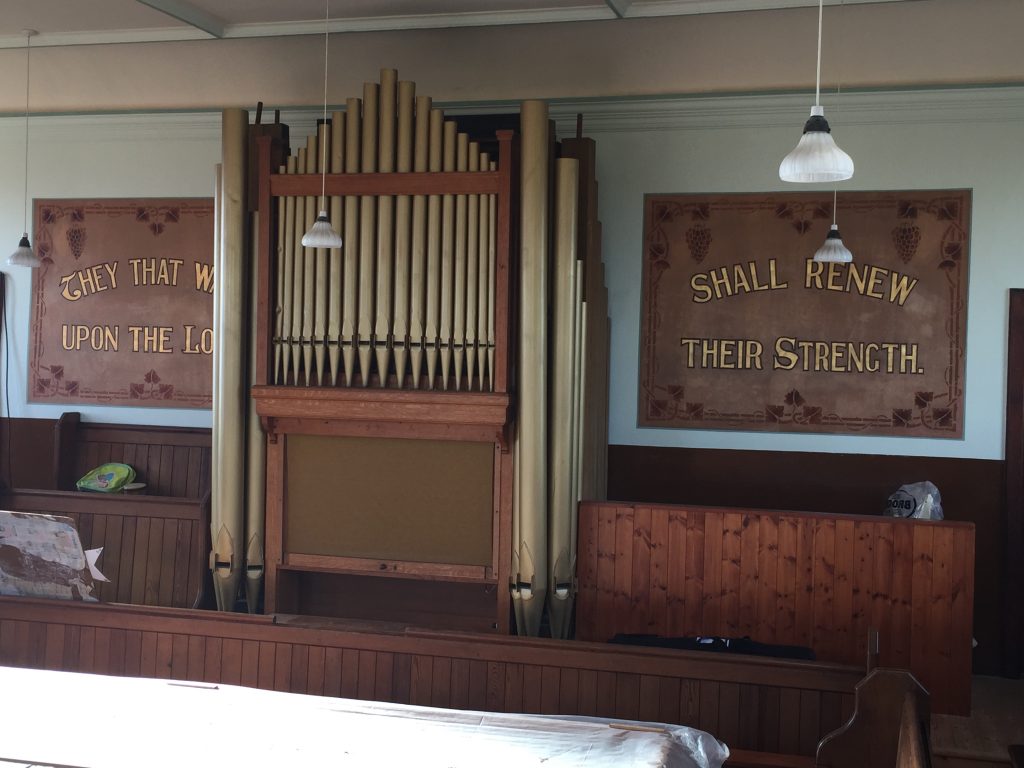
Beautiful stencil-work that Dot has lovingly preserved. Originally all the walls and ceiling were covered in stencil-work. A stencil artist has offered to redo it for free.
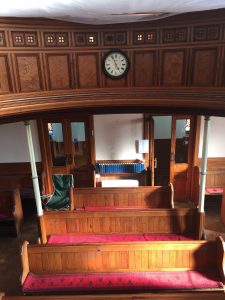
View from the pulpit
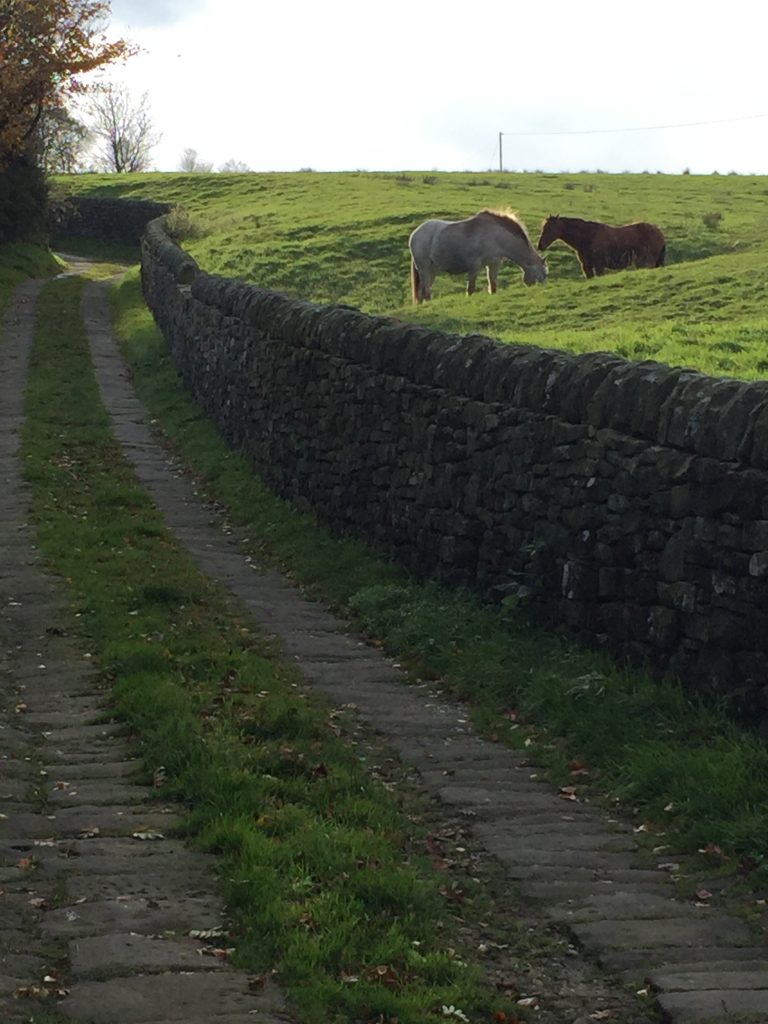
Old cobbled cart road
On the walk home I took photos just to show what an isolated community Blackshaw Head is.

Looking over to Slack
In the middle of March, 2020, when the government ordered everyone to stay at home because of the Corona Virus I read Birdsong by Sebastian Faulks. Much of it is set in Thiepval where Giles was buried. What a long way from Blackshaw Head.
Leave a Reply